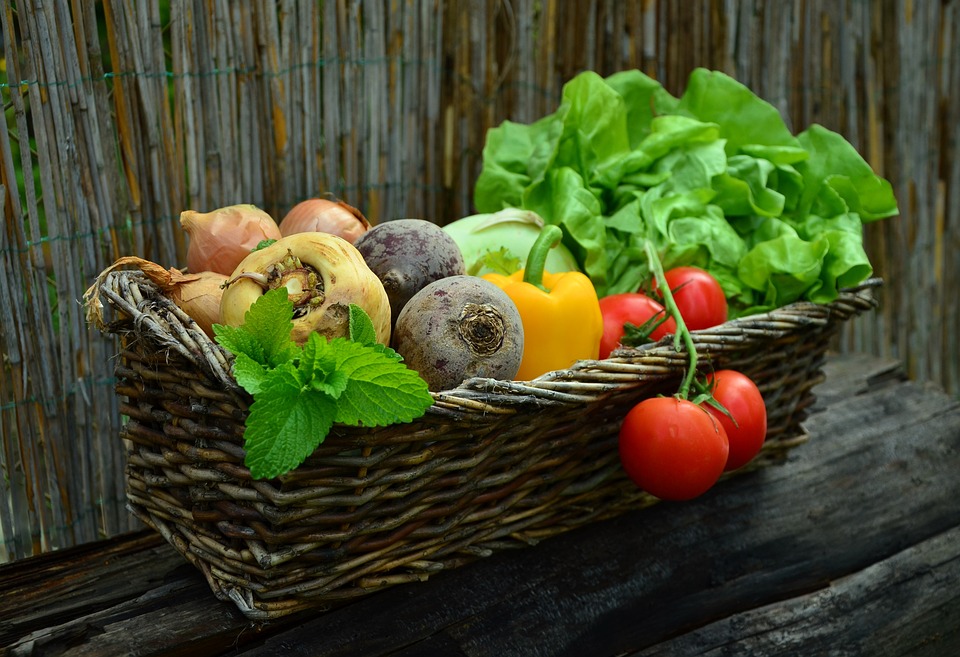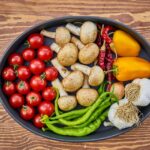Why choose organic? See the surprising difference between organic and non-GMO labels so you can make the best choices for your health. There’s a lot of confusion and debate about what non-GMO and organic labels really mean. The labels are very different! It’s crucial to understand the difference if you want to pick out the healthiest and safest food for you and your family.
What does “organic” mean?
The term “organic” refers to the way agricultural products are grown and processed. While the regulations vary from country to country, in the U.S., organic crops must be grown without the use of synthetic herbicides, pesticides, and fertilizers, or bioengineered genes (GMOs).
Organic livestock raised for meat, eggs, and dairy products must be raised in living conditions accommodating their natural behaviors (such as the ability to graze on pasture) and fed organic feed and forage. They may not be given antibiotics, growth hormones, or any animal by-products.
Understanding GMOs
The ongoing debate about the effects of GMOs on health and the environment is a controversial one. In most cases, GMOs are engineered to make food crops resistant to herbicides and/or to produce an insecticide. For example, much of the sweet corn consumed in the U.S. is genetically engineered to be resistant to the herbicide Roundup and to produce its own insecticide, Bt Toxin.
GMOs are also commonly found in U.S. crops such as soybeans, alfalfa, squash, zucchini, papaya, and canola, and are present in many breakfast cereals and much of the processed food that we eat. If the ingredients on a package include corn syrup or soy lecithin, chances are it contains GMOs.
GMOs and pesticides
The use of toxic herbicides like Roundup (glyphosate) has increased 15 times since GMOs were introduced. While the World Health Organization announced that glyphosate is “probably carcinogenic to humans,” there is still some controversy over the level of health risks posed by the use of pesticides.
Are GMOs safe?
While the U.S. Food and Drug Administration (FDA) and the biotech companies that engineer GMOs insist they are safe, many food safety advocates point out that no long term studies have ever been conducted to confirm the safety of GMO use, while some animal studies have indicated that consuming GMOs may cause internal organ damage, slowed brain growth, and thickening of the digestive tract.
GMOs have been linked to increased food allergens and gastrointestinal problems in humans. While many people think that altering the DNA of a plant or animal can increase the risk of cancer, the research has so far proven inconclusive.
Does organic mean pesticide-free?
As mentioned above, one of the primary benefits of eating organic is lower levels of pesticides. However, despite popular belief, organic farms do use pesticides. The difference is that they only use naturally-derived pesticides, rather than the synthetic pesticides used on conventional commercial farms. Natural pesticides are believed to be less toxic, however, some have been found to have health risks. That said, your exposure to harmful pesticides will likely be lower when eating organic.
Why Choose Organic? 10 Reasons Why “Organic” Beats “Non-GMO” Every Time:
1. Certified organic foods are also non-GMO.
USDA organic regulations prohibit any genetically modified (GMO) ingredients in a certified organic product. I avoid GMOs at all costs, and going organic is one of the easiest ways to do it.
NOTE: The USDA Organic label certifies that 95%-100% of the ingredients are organic, so there is a slight chance that (up to 5%) of non-organic ingredients are in the product – however they are not supposed to be GMO . There are still some tricky loopholes , so that’s why you need to look for “100% certified organic” or a “Non-GMO Project” verified label to ensure it’s GMO-free.
2. Organic crops cannot be grown with synthetic pesticides, and contain much lower pesticide residues overall.
Organic regulations prohibit certain toxic pesticides from being used on crops, but there are no special restrictions for non-GMO crops.
So, non-GMO crops can be grown the same as other conventional crops and can still be laden with toxic pesticide residues , including organophosphates that are linked to lymphoma and leukemia .
A bag of non-GMO potato chips can contain residues from up to 35 different pesticides used on conventional potatoes, several of which are known carcinogens, suspected hormone disruptors, neurotoxins, or reproductive toxins . Also non-GMO produce (like strawberries and celery) are on the EWG’s Dirty Dozen Guide as the most contaminated with pesticides.
While natural pesticides are allowed on organic crops, it’s been shown that organic produce has very low levels of pesticide residue compared with conventional crops , and by eating organic you can significantly decrease your exposure to pesticide residues ( source ).
3. The most widely-used herbicide on the planet – Glyphosate (Roundup) – is prohibited on organic crops.
Non-GMO crops such as wheat can be pre-harvested with glyphosate . This herbicide is a toxin that can accumulate in your body the more you are exposed to it. It has been linked to kidney disease, breast cancer, and some birth defects .
According to Dr. Stephanie Seneff , a senior research scientist at MIT, glyphosate is largely responsible for the escalating incidence of autoimmune and other neurological disorders that we are experiencing .
4. Organic ingredients aren’t processed with toxic hexane.
Most conventional oils (canola, soybean, corn) are extracted with the neurotoxin hexane , and some residue has been shown to remain in these oils.
Hexane is also used in the processing of many soy ingredients like soy protein and textured vegetable protein, and testing done by The Cornucopia Institute has found residues in some of these ingredients.
Almost all research focuses on the industrial use and inhalation of hexane: “No epidemiology or case report studies examining health effects in humans or chronic laboratory studies evaluating potential health effects in animals following oral exposure to n-hexane are available”.
5. Organic crops are prohibited from being fertilized with sewage sludge.
Conventional non-GMO crops can be treated with “biosolids” , which is literally the treated waste that’s flushed down the toilet, and waste from hospitals and industry.
This waste can be contaminated with such things as heavy metals, endocrine disruptors, pathogens, pharmaceuticals, pesticides, and dioxins – it’s basically a toxic chemical soup !
It’s been shown that some of these contaminants are absorbed into (or remain as residue on) the crops that we eat. These residues have proven deadly to cattle that have grazed on crops fertilized with biosolids, and it certainly isn’t something we should be eating.
6. Organic meat isn’t produced with growth-promoting drugs, like ractopamine.
Packaged non-GMO foods may contain meat that has been raised on growth-promoting steroids and drugs.
Residues of some of these drugs have been found in meat and it’s been shown that eating products with traces of ractopamine can lead to an unacceptable level of risk of diseases of the cardiovascular system.
7. Organic animals aren’t fattened up with growth-promoting antibiotics.
The overuse of growth-promoting antibiotics is creating superbugs that could threaten the entire human population .
Antibiotics have been used for years, not just to fight infection, but to fatten up farm animals . This use is polluting our environment, water and food supply.
Studies show that antibiotics have the same consequences for us, and can fatten us up too . This is because antibiotics kill off healthy bacteria in the gut – beneficial bugs called probiotics that influence how we absorb nutrients, burn off calories, and stay lean.
8. The non-GMO label claim is unregulated.
Essentially anyone can say that their product is non-GMO, because the FDA has not set any standards to regulate the use of this claim on a label. This is not to be confused with the Non-GMO Project label, as they have a process for verifying whether products are non-GMO, and I feel that their label can be trusted (just as Whole Foods will only label products as non-GMO if they carry the Non-GMO Project verification label or are certified organic ).
There’s another big reason to eat organic… It can help you stay thin!
9. Organic foods prohibit many of the chemicals known as “obesogens” that trigger our bodies to store fat.
Antibiotics, growth hormones, pesticides, and synthetic preservatives are just a few of the chemicals that researchers have defined as obesogens . The theory that obesogens in our food and environment could be making us fat has been gathering steam ever since researcher Paula Baillie-Hamilton published an article in the Journal of Alternative and Complementary Medicine in 2002, presenting strong evidence that chemical exposure caused weight gain in experimental animals.
As reported in the New York Times piece, “Warnings From A Flabby Mouse” , exposure to endocrine disrupting chemicals can cause weight gain . This is important because many of the synthetic pesticides that can be found on non-GMO conventional crops are endocrine disruptors. Also – the sewage sludge fertilizing some of these crops has been shown to contain endocrine disruptors.
Minimizing your exposure to obesogens by choosing an organic diet may be the boost you need to lose weight and keep it off.
10. By choosing organic food, you’ll automatically avoid most of the “Sickening 15” ingredients that I talk about in my book, The Food Babe Way
Chemicals like synthetic preservatives, synthetic pesticides, growth hormones and antibiotics are not used in organic food.
These are the chemicals that can make you tired, wreak havoc on your skin, make you feel fat and miserable, even though you’ve been dieting and exercising like crazy. Even worse – they may put you at risk for scary, life-shortening diseases like cancer.
The benefits of organic food
How your food is grown or raised can have a major impact on your mental and emotional health as well as the environment. Organic foods often have more beneficial nutrients, such as antioxidants, than their conventionally-grown counterparts and people with allergies to foods, chemicals, or preservatives may find their symptoms lessen or go away when they eat only organic foods.
Organic produce contains fewer pesticides. Chemicals such as synthetic fungicides, herbicides, and insecticides are widely used in conventional agriculture and residues remain on (and in) the food we eat.
Organic food is often fresher because it doesn’t contain preservatives that make it last longer. Organic produce is sometimes (but not always, so watch where it is from) produced on smaller farms nearer to where it is sold.
Organic farming tends to be better for the environment. Organic farming practices may reduce pollution, conserve water, reduce soil erosion, increase soil fertility, and use less energy. Farming without synthetic pesticides is also better for nearby birds and animals as well as people who live close to farms.
Organically raised animals are NOT given antibiotics, growth hormones, or fed animal byproducts. Feeding livestock animal byproducts increases the risk of mad cow disease (BSE) and the use of antibiotics can create antibiotic-resistant strains of bacteria. Organically-raised animals tend to be given more space to move around and access to the outdoors, which helps to keep them healthy.
Organic meat and milk can be richer in certain nutrients. Results of a 2016 European study show that levels of certain nutrients, including omega-3 fatty acids, were up to 50 percent higher in organic meat and milk than in conventionally raised versions.
Organic food is GMO-free. Genetically Modified Organisms (GMOs) or genetically engineered (GE) foods are plants whose DNA has been altered in ways that cannot occur in nature or in traditional crossbreeding, most commonly in order to be resistant to pesticides or produce an insecticide.
Why is organic food often more expensive?
Organic food is more labor intensive since the farmers do not use synthetic pesticides, chemical fertilizers, or drugs. Organic certification is expensive and organic feed for animals can cost twice as much. Organic farms tend to be smaller than conventional farms, which means fixed costs and overhead must be distributed across smaller produce volumes without government subsidies.
Organic food buying tips
Buy in season. Fruits and vegetables are cheapest and freshest when they are in season. Find out when produce is delivered to your market so you’re buying the freshest food possible.
Shop around. Compare the price of organic items at the grocery store, the farmers’ market, online, and in other venues (even the freezer aisle).
Remember that organic doesn’t always equal healthy. Making junk food sound healthy is a common marketing ploy in the food industry but organic baked goods, desserts, and snacks are usually still very high in sugar, salt, fat, or calories. It pays to read food labels carefully.
Why is organic food often more expensive?
Organic food is more labor intensive since the farmers do not use synthetic pesticides, chemical fertilizers, or drugs. Organic certification is expensive and organic feed for animals can cost twice as much. Organic farms tend to be smaller than conventional farms, which means fixed costs and overhead must be distributed across smaller produce volumes without government subsidies.



